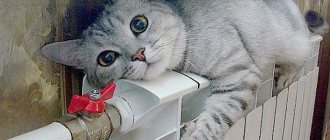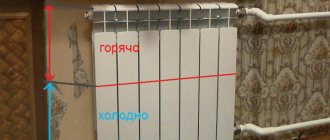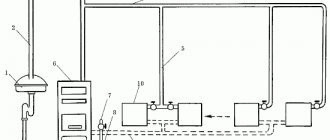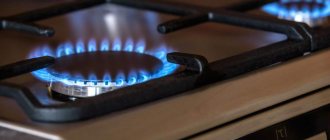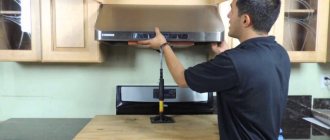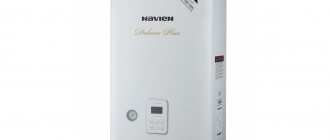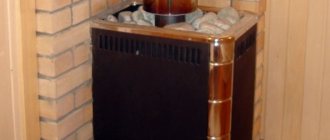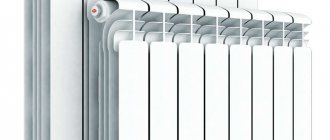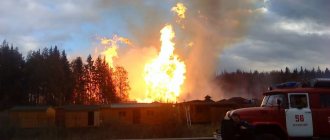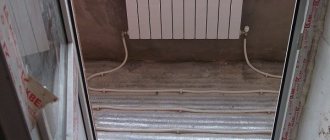Fight for warmth
It is better to think about possible heat loss in your home in the summer. But if this has not been done, then it is possible to insulate the house with the onset of winter. The first thing to do is to identify weak points where heat loss is possible.
Windows according to standards
The main source of cold is windows. Nowadays there are double-glazed windows above heating radiators and radiators almost everywhere. But even plastic window frames age. The sealing rubber becomes unusable.
Central heating in the apartment
The windows begin to let in the cold. The easiest way is to stretch plastic film over the frames. It is sold in stores in rolls. This material does not have any effect on the transparency of the glass. Heat loss in radiators or radiators will be reduced.
The film is fixed to the glass. Before this, the frames are thoroughly washed. Double-sided tape is applied around the perimeter. A film is attached to it. It's easier to do this together.
Battery on the wall
If wrinkles have formed on the coating, heat the film with a hairdryer until they straighten out. Then all that remains is to seal the frames. They do this with single-sided tape. Such a simple method helps to retain up to 20% of heat.
Every morning you should open the curtains and raise the blinds. The apartment is perfectly warmed by sunlight penetrating into the room through the glass. Double glass frames create a magnifying effect, enhancing the warmth of sunlight. When it gets dark, the windows should be closed. At night, glass draws heat out of the room.
Radiator under the central window
Batteries according to standards
The batteries are located along the walls. Dank damp partitions take away heat. A simple reflector will help avoid this. A reflector is not a technical device. This is simply a sheet of foil attached to a radiator or radiator.
The reflector sheet is made slightly larger than the area occupied by the radiator or radiator. A homemade reflector will raise the room temperature by at least 2 degrees.
Porilex and penofol have lower thermal conductivity than foil. This is facilitated by the insulation layer they have.
Heating batteries
It is necessary to require compliance with water standards in heating devices from utility services. But the comfort in the house cannot be left only to the mercy of the management company. It is always safer to take care of the microclimate in your home yourself.
Temperature of heating radiators in the apartment standards
Apartment heating standards determine the specific value of a sufficient indicator for residential and non-residential premises, with permissible deviations from their indicators.
They are developed more simply than for work premises, since those living in the housing exhibit low and, at the same time, stable activity:
- For residential premises, the air temperature is from 20 to 22 degrees Celsius, while acceptable limits are considered to be from 18 to 24 degrees;
- If we take corner rooms, then the indicator should not be less than twenty degrees, since such rooms are more susceptible than others to low external temperatures and winds;
Temperature in the apartment in winter: legal norm
GOST temperature in an apartment in winter is regulated by the following document - GOST R 51617-2000. It is in this document that it is officially established that the temperature in a heated room in winter should vary from plus 18 to plus 25 degrees Celsius.
But a spread of 7 degrees is quite significant, which is why this fork between 18 and 25 degrees depends on several factors:
- The specific room and its purpose: in living rooms the temperature should start from 18 degrees, a parameter of 25 degrees, as a rule, applies to bathrooms with high air humidity. The air in the bathrooms should be better heated, since otherwise high humidity can cause damage to the room in the form of mold and the proliferation of pathogenic bacteria.
- Time of day: the daytime temperature in a living room must be strictly observed, but as for the temperature at night, there are some relaxations. If the temperature in the apartment at night drops 1-3 degrees below normal, this is not considered a violation.
It is also worth noting that discomfort for a person can be created not only by low temperatures, but also by too high temperatures. Overheated air does not have the best effect on a person, so the upper limit in GOST is also specified - in a living room the air temperature should not rise above 24 degrees Celsius.
Air ratio parameters
The room must have a certain air exchange rate, for example, if the room is residential and has an area of 18 or 20 m2, then the rate should be 3 m3/h per square meter. m., the same parameters are also necessary in regions where the temperature reaches −31°C and drops below. In dormitory kitchens and apartments equipped with electric and gas two-burner stoves and having an area of up to 18 m2, aeration is 60 m3/h. If there is a three-burner appliance in the room, then this value will be 75 m3/h, if there is a gas stove with four burners - 90 m3/h. For a bathroom with an area of 25 m2, the air exchange rate should be 25 m3/h, and for an individual restroom with an area of 18 m2 - 25 m3/h. If the bathtub and toilet are combined and their area is 25 m2, then the aeration is 50 m3/h. If the common restroom has an area of 16 m2, then an air exchange rate of up to 50 m3/h is required for one toilet, and 25 m3/h for a urinal. If the room is corner, then the room should be 2°C higher than usual. During warm periods, the temperature in the elevator room should not exceed 40°C.
Requirements for heating networks
With centralized heat supply, the heat source is a boiler house or a thermal power plant, where high-temperature water-heating boilers are installed (in thermal power plants - steam boilers). The fuel is usually natural gas, with other energy sources being used to a lesser extent. The temperature of the coolant at the outlet of the hot water boiler is 115 °C, but the water does not boil when it is under pressure. The need to heat up to 115 °C is explained by the fact that boiler plants operate at maximum efficiency in this mode. The transition from 115 °C to the required temperature value is provided by plate or shell-and-tube heat exchangers. At a thermal power plant, waste steam from turbines enters heat exchangers to produce electricity. According to regulatory requirements, the water temperature in heating pipes should not exceed 105 ° C, the lower limit depends on street conditions. In this range, the heating of water in the heating network is regulated depending on the weather, for which each boiler room has a temperature graph of the heating system. For home networks, 2 calculation schedules are used: 105/70 °C; 95/70 °C.
These figures show the maximum temperature of the supply and return water during the most severe frosts in a particular area. But at the beginning and end of the heating season, when the weather is not yet too cold, there is no point in heating the coolant to 105 °C, so a real temperature heating schedule is drawn up, which describes to what extent the water should be heated at different outside temperatures. The dependence of heating on weather conditions is shown in the table, which presents excerpts from the graph for the city of Ufa: Average daily street air temperature, °C at the supply with a design schedule of 105/70 at the supply with a design schedule of 95/70 in the return +8 43 41 36 56 52 43 -5 64 59 48 -10 71 65 52 -15 78 72 56 -20 85 78 59 -25 92 84 63 -30 99 89 67 -35 105 95 70
The table is presented as an example and is correct only for this city; another locality has its own dependence, because the climatic conditions in the country are different. It is quite difficult to find out exactly what the coolant temperature is in a centralized heating network. To do this, you need to have a remote thermometer that determines the degree of surface heating. So, it is possible to determine to what extent the heating standards in the apartment are met only by the air temperature in the rooms.
What to do if there is no heating?
In the event that GOST for heating in an apartment is far from its norm, it is necessary to determine the cause of cold radiators. To do this, it is better to call representatives of the relevant service , since they can simultaneously record the temperature in living quarters.
If the problem is poor quality maintenance of the home heating system by heating network workers, then all the burden of troubleshooting will fall on the organization. At the same time, residents of the house must either be recalculated for heating if the radiators do not heat enough, or record the period when they were completely cold and be exempt from payment.
Thus, the law on heating of apartment buildings (2017) guarantees residents protection if utility services fail to comply with their duties .
Any application from them must be considered as soon as possible, after which a special commission comes and documents the discrepancies.
Knowing how many degrees the heating should be in the apartment, and at what time the system is turned on, each owner can independently determine whether the indicators comply with heating standards in the apartment and take measures if this is not the case.
With the arrival of autumn cold, when thermometer readings drop to 8-10 degrees Celsius, and real winter begins in the northern regions of Russia, the use of the word form “heating season” becomes appropriate. And during this period, it makes sense to understand the basic standards for coolant temperature in the heating system, which are regulated by the state.
When the heating season arrives, owners of private houses and cottages independently open the valves and nozzles of boiler systems. In apartment buildings, things are a little different, and residents are forced to wait impatiently for a plumber from the management company, who will start the heating system and allow people to feel confident in the future.
It is no secret that in multi-apartment buildings of economy class, heating is carried out through a centralized heat supply system. All heating lines are hidden in the basement, and the supply of coolant is regulated using water valves, behind which there are sump tanks and risers. Passing through the last nodes, the liquid is supplied to batteries and radiators, which start heating the surrounding space.
The number of valves must correspond to the number of risers. The presence of these elements allows one apartment to be disconnected from the general system for the duration of any repair work. The spent coolant ends up in the return pipe and also partially penetrates the hot water supply network.
The creation of liquid for a heating installation occurs at a thermal power plant or in a boiler room. Heat supply standards in an apartment building are regulated by the relevant building rules: the coolant must be heated to 130−150 degrees Celsius. When drawing up current standards, it is necessary to take into account the parameters of the ambient air. For example, for the Southern Urals, minus 32 degrees should be taken into account.
Read more: Types of disciplinary sanctions in the labor code
To prevent the liquid from boiling, it is supplied to the network under a pressure of 6-10 KGS. However, this is only a theoretical statement. In fact, a significant part of the heating mains operate at 95-110 degrees Celsius, which is explained by their poor condition.
The concept of “norm” is very loose. Heating radiators never warm up to the temperatures possessed by the coolant. In this case, the energy-saving function will be assigned to another part of the system - the elevator unit, which is a jumper between the direct and the return pipe. According to current standards, the temperature of the liquid in the system through the return pipe in winter can be 60 degrees Celsius.
During the cold winter season, it is time to heat the apartments.
According to the law of the Russian Federation, we are provided with high-quality central heating at subsidized prices.
What should you really expect during the heating season? How high quality and effective it will be.
Temperature measurement techniques
An ordinary household thermometer on the surface of a heating device. A device designed to measure temperature in a non-contact manner. Such a meter is called -
. Alcohol thermometer. A special electrical device. If you take measurements with an ordinary thermometer, you will need to add a few more degrees to the indicators. The most accurate readings can be obtained using an infrared device - a pyrometer. Its error is no more than 0.5 degrees. To regularly monitor temperature, use only the safest device - an alcohol thermometer. For these purposes, it is attached to the radiator using tape and wrapped in thermal insulation material. How to use the electric version of the thermometer? You need to take a wire with a thermocouple and attach it to the heating device. This is how the indicators are taken. If a commission comes to your apartment to measure the temperature of the batteries, they must have a certified device. You have the right to demand from a representative of the inspecting organization documents confirming that the equipment has passed state verification. Very serious requirements are imposed on the heating system. The process of delivering hot coolant using circulation pumps (the installation rules for the heating system are written here) to a residential building and its uniform distribution throughout all apartments is not an easy task. This issue must be approached responsibly, and with an understanding of all the technological subtleties. In order for the heating system to work efficiently, all its elements must function harmoniously. This applies to all pipes and radiators in each of the apartments of a multi-story building. Therefore, when replacing radiators (read how to install heating radiators in a private house in this article), you need to take into account the features and subtleties of the heating main. If this is not done, some apartments will experience an excess of heat, while bad times will come for the residents of other apartments (they will have cold radiators). How can the heating of urban dwellings be optimized? Answer: by introducing the following standards: the safety regulations state that the temperature of the working liquid substance in the heating main must be 20 degrees less than the temperature of self-igniting materials. For residential multi-apartment buildings, the coolant limit has established standards - 65 - 115 degrees Celsius (this takes into account seasonality); if the water, for some reason, overheats and reaches a reading of 105 degrees, emergency measures must be taken to prevent it from boiling; the standard limit for water circulating through the batteries is 75 degrees. In case this indicator is exceeded by the battery needs to install a restrictive structure (about methods of heating in a private house is written here); in regions located in the middle latitudes of our country, the heating season, as a rule, begins on the fifteenth of October and ends on the fifteenth of April. In some cases, these standards may be changed. Service providers should rely on the average daily outdoor temperature.
Battery temperature
There are minimum and maximum standards. Sometimes, even when heating is started, there is not enough heat in the room due to the fact that the temperature of the radiators is far from the standards. The reason for this is the banal airiness of the system. You can fix the problems with the help of a specialist or yourself using a Mayevsky crane.
If the problem arises due to worn-out riser pipes or batteries, then you simply cannot do without the help of specialists. If the heating system did not work and the air in the apartment was colder than specified in GOST standards, then this entire period is not subject to payment.
There are no minimum temperature standards for heating radiators, so it is customary to rely on the air parameters in the apartment. Normal air parameters during the heating period are +16…+25°C.
To document that the temperature of the heating system does not meet the norm, it is necessary to invite an authorized representative of the heating service provider. What the water temperature in the batteries should be is described in SNiP 41−01 of 2003:
- If a two-pipe design is used in the room, then 95°C is the maximum.
- The norm for a single-pipe design is +115°C.
- The winter temperature norm for heating radiators in an apartment is +80…+90°C. If it approaches +100°C, then urgent measures must be taken to prevent water from boiling in the system.
Although many battery manufacturers often specify a maximum temperature threshold that is high, you should not reach it frequently as this will damage the battery.
To ensure that the heating complies with GOST standards, you need to take your own measurements and understand what the temperature of the water in the heating radiators is:
- An ordinary mercury thermometer can be used, but then 2°C will need to be added to the result obtained.
- An infrared thermometer will also work.
- The alcohol thermometer must be tightly tied to the battery, wrapped in thermal insulation.
If the results obtained are far from normal, then you need to submit an application to the heating network office with a request to carry out control measurements . A commission will visit the apartment and make all the necessary calculations.
The apartment is cold, why complain?
Before you go looking for heat, you should remember that heat in the room will be supplied through the heating system only when the outside temperature reaches a certain level.
Standards require heating to start when the outside temperature is no more than 8 degrees. This temperature indicator must last for five days in a row, and only after this the rooms will begin to be heated.
When the heating in the house is adjusted, and temperature deviations are observed only in your room, it is necessary to check the indoor heating system for airing.
It is enough to feel the individual batteries in the apartment from top to bottom, and back. If some of the batteries are noticeably warm and the rest are cold, you can be sure that airing is the cause of the thermal imbalance. The air is released using a separate tap, which is located on each radiator battery.
Before opening the tap, you should place some container under it. When you open the tap, water should come out of it with a characteristic hissing sound. If the water begins to flow smoothly and without hissing, it means that the air has been released from the system, and the job is done.
After this, you should fix the tap in the closed position. After a while, check the cold spots on the battery, they should warm up.
If the problem is not with the batteries and they are completely cold, you should contact the management company. The technician will arrive within 24 hours. He will be able to draw a conclusion about the temperature conditions in the home and, if necessary, call a team that will fix all the problems.
When the management company did not respond to your appeal or the appearance of a technician did not change the situation, you should take temperature measurements in your home yourself, calling your neighbors.
When you have a device such as a pyrometer at your disposal, you should use it to take the necessary temperature measurements. Record all data in a report on measuring the air temperature in your home. It is compiled in the usual form. Let the neighbors sign the act.
You should pay attention to the fact that the temperature regime is determined by the “Sanitary and Epidemiological Requirements for Residential Buildings and Premises” SanPiN 2.1.2.1002-00. Recorded measurements should be compared with the limit values specified in SanPiN
Then you need to go back to the management company and the organization that supplies the house with heat to write a written complaint
Recorded measurements should be compared with the limit values specified in SanPiN. Then you need to go back to the management company and the organization that supplies the house with heat to write a written complaint.
The document is drawn up in two copies. One of the copies must be in your hands with a stamp, signed indicating the details of the person who accepted the document and the date of receipt of the document. The second one must be submitted for consideration.
If you were not satisfied with the answer, then there is no need to leave everything halfway, move on. You should contact the district Prosecutor's Office and the Housing Inspectorate, since it is she who is authorized to monitor the work of the management company and other communal structures.
Also write a letter to Rospotrebnadzor (based on the violation of your consumer rights). You can use the Rospotrebnadzor hotline (8-80-010-000-04).
Dear readers!
If you want to know, Or call us at:
8 ext. 214 Federal number (free call for all regions of Russia)!
Was the Recording helpful? Yes No 49 out of 67 readers found this post helpful.
What to do in case of discrepancies
If deviations from the permissible temperature conditions of the batteries are observed only in your apartment, you should check the indoor heating system. It is necessary to determine whether it is airy.
Remember! Touch the radiators in different rooms throughout the area to determine whether all areas are heated evenly. If there are warm and cold areas, aeration occurs. You need to let the air out by opening the valve on the radiator battery.
Remember that you cannot open the taps without first placing a container under them to drain the water. Close the tap at the moment when the water flows smoothly, without hissing. After this, check those parts of the battery that were cold. They should warm up.
If the cause of the low temperature is not due to air pollution, file a claim with the management company. If a response to the complaint has not been received, measure the temperature of the batteries and draw up a report of non-compliance in the presence of neighbors.
Watch the video. Temperature standards in the apartment:
Strict recording of temperature standards for heating radiators in an apartment is important
Knowing the room temperature standards will help you detect a malfunction and contact the appropriate authority for a solution.
Temperature indicators are regulated by GOST and SNiP standards.
ontakte
Odnoklassniki
The main indicator is indicated in document number 51617-2000. In accordance with it, the temperature should be:
- on a flight of stairs - 14-20 degrees;
- in the lobby and corridors - 16-22;
- in hallways, living rooms and other rooms of the apartment - 18-25;
- in the bathroom - about 24.
The temperature is more precisely regulated by GOST 30494-2011:
| Season | Room | Recommended value +/- 1 |
| Cold | Residential | 21 |
| Residential, in the north | 22 | |
| Kitchen | 20 | |
| Toilet | 20 | |
| Bathroom | 25 | |
| Inter-apartment corridor | 19 | |
| Children's | 24 | |
| Warm | Any | 23 |
Minimum indicators
Heating rooms is important at any time of the year, but especially in winter.
The heating system has typical temperature values that must be observed.
For each room there is a small interval presented in the table above. There is no minimum threshold as such.
But there are several indicators, a drop below which indicates a malfunction. This applies to heating premises: the law allows the temperature to drop to 12, 8 and even 4 degrees, but only for a short period of time - 16, 8 and 4 hours, respectively.
Maximum water temperature in radiators
SNiP 41-01-2003 establishes temperature limits from above: for piping from one pipe, heating of the coolant is allowed to 115 degrees, from two - up to 95°C. Despite the permitted values, they rarely exceed 80-85°C.
Attention! These rules apply to indoor parts of the heating system
Parameters by which central heating in the house is turned on
The Decree of the Government of the Russian Federation characterizes the need to turn on the heating at an average street temperature of +8°C or less. When heating, the temperature is measured at +5°C or more. Both values must last for at least 5 days in a row.
How to adjust and increase heat transfer
To change the temperature of heating radiators, it is necessary to install special regulators on them. There are 4 types of such devices: regulators with a locking mechanism, manually controlled valves, thermostats with automatic settings, radiator thermostats.
Photo 2. Manual thermostat for a radiator. By turning the knob you can set the desired temperature.
In order to increase the temperature of the radiator, it is necessary to open the regulator and let more coolant into the heating device. And, conversely, to lower the temperature, it is necessary to drain excess coolant.
What to do if there is no heating and a radiator malfunction
After detecting a problem, it is necessary to draw up a report indicating the unacceptably low temperature in the room. They contact the organization that supplies heat. The statement indicates the period during which the problem has been observed and the actual thermometer values. Based on the information, an inspection is carried out, compensation is calculated and a decision is made.
By law, during the heating season there can be a break of no more than 24 hours per month. The following conditions correspond to this: the temperature cannot fall below 12 degrees, and the shutdown should not last 16 hours in a row.
Important! There are two exceptions: the room can be 8-12 degrees for up to 8 hours in a row, or from 4 to 8, but no more than 4. Watch the video, which talks about what heating standards should be in an apartment
Watch a video that talks about what heating standards should be in an apartment.
Knowledge of SNiP and GOST standards will help to detect the problem, solve it and receive compensation for failure to fulfill obligations by the supplier.
Rate this article:
Be first!
Average rating: 0 out of 5. Rated by: 0 readers.
ontakte
Odnoklassniki
Norms in Russia
Considering the main indicators, the official temperatures of the heating radiators in the apartment are shown below. They are applicable for absolutely all existing systems in which, in direct accordance with the Decree of the Federal Agency for Construction and Housing and Communal Services No. 170 of September 27, 2003, the coolant (water) is supplied from the bottom up.
Dear readers!
Our articles talk about typical ways to resolve legal issues, but each case is unique. If you want to find out how to solve your specific problem, please contact the online consultant form on the right →
It's fast and free!
Or call us by phone (24/7):
If you want to find out how to solve your particular problem, call us by phone. It's fast and free!
+7 Moscow,
Moscow region
+7 Saint Petersburg,
Leningrad region
+7 Regions
(free call for all regions of Russia)
| Indoor air temperature indicators | Reverse movement | Supply pipes |
| 5°C | 39°C | 50°C |
| 4°C | 41°C | 53°C |
| 3°C | 43°C | 56°C |
| 2°C | 45°C | 59°C |
| 1°C | 46°C | 62°C |
| 0°C | 48°C | 65°C |
| -1°C | 50°C | 67°C |
| -2°C | 51°C | 70°C |
| -3°C | 53°C | 73°C |
| -4°C | 54°C | 76°C |
| -5°C | 56°C | 78°C |
In addition, it is necessary to take into account the fact that the temperature of the water that circulates in the radiator directly at the entrance to the functioning heating system must correspond to the current schedules regulated by the utility networks for a particular room. These schedules are regulated by Sanitary Standards and Rules in the sections of heating, air conditioning and ventilation (41-01-2003). Here, in particular, it is indicated that with a two-pipe heating system the maximum temperature indicators are equal to ninety-five degrees, and with a single-pipe heating system - one hundred and five degrees. These measurements must be carried out consistently in accordance with established rules, otherwise, when contacting higher authorities, the readings will not be taken into account.
Methods for measuring water in radiators
When considering the question of how to measure the temperature of a battery in an apartment, the following methods can be distinguished:
- an ordinary thermometer (on the surface of the radiator);
- infrared thermometer;
- alcohol thermometer;
- special electrical device.
When measuring with a regular thermometer, you need to add 1-2 degrees to the result. A more accurate result will be given by an infrared device, the error of which is 0.5 degrees.
In order to regularly monitor the temperature of the water in the batteries, you can use an alcohol thermometer. To do this, the device is attached with tape to the radiator and wrapped in heat-insulating material.
The battery may not heat up evenly.
You can also use an electric version of the thermometer for measurements. To do this, a wire with a thermocouple is wound to the battery, and it takes readings of the degree of heating. If a consumer calls a special commission to measure the temperature of heating radiators in an apartment, then their device must have a quality certificate and first pass state inspection. The actions of specialists must comply with GOST 30494-96 (clause 4 in the “Control methods” section).
If the temperature of the heating pipes in the apartment is higher than normal, then it can be adjusted in several ways:
- using special devices;
- ventilation;
- using thick curtains.
There are special taps with which you can regulate the temperature. They are installed on each radiator. A simpler method is to ventilate the room. You can also simply use curtains made of dense material, which will let less sunlight into the room. It is much easier to deal with high room temperatures than low ones. What to do if the minimum temperature of the batteries in the apartment is lower than indicated in the temperature chart? To do this you should:
- call utility services;
- insulate windows, doors and walls;
- install new radiators.
If you don’t know how to check the temperature of the batteries in the apartment, you can call specialists. Also read: “Blowing and cleaning batteries.”
Utility services measure plumbing and heating systems. After this, an act is drawn up. Then, if the tenant's claims are confirmed, utility companies must increase or decrease water heating. Another way would be to install new heating radiators. Details about the installation can be found in the video:
You should pay attention to the material from which the batteries are made. Aluminum radiators have high thermal conductivity, so they will transfer heat well
But cast iron, although they are able to retain heat longer, will release it more slowly. Because of this, the room will take a long time to warm up.
Aluminum radiators have high thermal conductivity, so they will transfer heat well. But cast iron, although they are able to retain heat longer, will release it more slowly. Because of this, the room will take a long time to warm up.
The speed of water movement also affects the temperature in the heating pipes in apartments. Don’t forget that corner apartments are always cooler, because they have more walls in contact with the street. To reduce heat loss, it is necessary to insulate the walls. Insulating windows and doors through which cold air enters will also not be superfluous.
You can read more about infrared heating and energy consumption in this article.
Temperature conditions in the heating system of an apartment building
The heating season begins when the average daily temperature over the last five days reaches 8°C . Then water is supplied to the heating network at a temperature of 70°C .
With further cooling, boiler houses can increase the supply temperature to 115°C . Large thermal power plants (CHPs) have the ability to supply water up to 150°C .
As you know, the boiling point of water is 100°C, but due to high pressure the boiling point increases.
Before entering directly into the apartments, the water enters the central heating point, which is located in the basement of a multi-story building. There it cools down to an acceptable standard. From the radiators, water is sent back to heat up and return to the apartment.
What should be the normal temperature in the heating riser and radiators?
The optimal scheme for supplying water to coolants directly depends on the temperature outside the window. -4°C outside with a calculated difference of 105°C - 70°C and supply according to the “bottom-up” scheme, the supply water temperature to the battery should be 76°C and 54°C for the return. Under the same conditions, but at 0°C outside the window, the supply is heated to 65°C , and the return is 48°C .
For a two-pipe heating system, the maximum permissible temperature is 95°C. For single-pipe structures 115°C . The system can be determined by the number of pipes suitable for the battery. As a rule, single-pipe structures are installed in old houses, but double-pipe ones are much more economical.
How to measure coolant temperature
There are several options for measuring the temperature in the battery at home:
- If you have a heat meter, check the readings.
- Take measurements with an infrared thermometer .
Photo 1. The process of measuring the temperature in the battery using an infrared thermometer. The device gives very accurate readings.
- If you have an alcohol-based thermometer, wrap it in heat-insulating material and secure it to the battery. You can also use mercury thermometer, but then the error will be higher.
- If you have a tap , carefully drain some water and take measurements using any available method.
Read more: Application for an old-style international passport
Attention! If the temperature in the batteries is higher than the permissible norm , then you need to write a statement to the service company. After which a special commission, in the presence of the resident, will carry out a control measurement using a certified device. Otherwise, your battery risks failing.
Standards for heat consumption in winter in apartments
Standards for temperature conditions are established by SNiPs (a set of building codes and regulations) and are protected by law, therefore their violations are administratively punishable for public utilities. List of basic norms:
- The minimum temperature for corner rooms is 20°C , if the average daily temperature over the last 5 days reaches -31°C, the norm is 22°C.
- For residential premises 18°C, and 20°C in severe frosts (similar to 5 days at -31°C ).
- For the kitchen 18°C .
- For a studio kitchen 20°C.
- For the toilet 18°C .
- For the bathroom 25°C .
- With a shared bathroom 25°C.
- For vestibule, pantry, landing 15°C.
- For the attic and basement 4°C.
- For the elevator 5°C.
Reference. In Khabarovsk, Magadan and other cold regions, temperature standards for residential premises are 2°C higher.
Boiler water temperature
Individual heating allows you to avoid many of the troubles that could occur with central heating.
Depending on the situation outside, normal temperatures can range from 30°C to 90°C . As a rule, boilers have a limiter that prohibits heating above 90 degrees.
If your boiler does not have a limiter, heating above 90°C is not recommended for several reasons:
- This is prohibited by sanitary standards; at this temperature, dust and paint coatings begin to decompose.
- Polymer lines are designed for water with a temperature of no more than 85°C . If the operating rules are not followed, deformation and, as a result, leakage may occur.
- Operating at the maximum permissible temperatures will lead to rapid wear of batteries and pipes.
Norm for an apartment
What temperature should the heating radiators of an apartment building be? It is useful to know that each room has its own heating standard in an apartment building (2017). Heating standards in apartment buildings 2021: for a living room it is +18; Heating standards in corner apartments due to the presence of external cold walls are higher - +20 degrees; for the kitchen +18; bathroom - +25. This applies to apartments, while for common areas the indicators are as follows: in the entrance - +16; for an elevator it is +5 degrees; in the basement and attic - +4. All measurements in the apartment must be carried out along the internal wall of the room at least 1 m from the nearest external wall and 1.5 m from the floor. If the obtained parameters do not comply with the standards, then they should be presented to the heating network management. In this case, payment may be reduced by 0.15% for each hour of deviation.
How to increase or decrease the temperature in the apartment
The ball valve is closed at the supply level.
How many degrees should it be in the house? According to GOST, the lower limit in the room, taking into account the nighttime error, is 15 degrees. You wouldn't wish such comfort on your enemy. Naturally, complaining in this case is useless, because the requirements of the standard are met, so people begin to independently regulate the temperatures in their homes. When it’s cold, everyone actively insulates, replaces windows and seals cracks. As a last resort, you can turn on the oil heater.
But what to do if the normal temperature in the apartment in winter is 28 degrees, which is quite realistic. The maximum permissible value is 24 degrees plus the error of 4 degrees prescribed in GOST.
If the batteries have thermal heads, then there is no problem, you just need to set the required value and that’s it.
What to do if they are not there? Living with an open window is not comfortable, as cold air is strongly drawn across the floor. If there are children, then this option is excluded, and this state of affairs is clearly not healthy for adults.
What other options:
- slightly turn off the tap in front of the battery;
- install an air recuperator.
By closing the ball valve in front of the radiator, you will reduce the amount of water supplied. It is not recommended to do this, but when you really need to, you have to. Just keep in mind that in this mode, the shut-off valves will last much less. The air recuperator allows you to create the necessary air circulation, while the supply air enters the room already heated.
Heat supply requirements
According to the above-mentioned Resolution, central heating is launched after 5 days, during which the average outside air temperature does not exceed +8 °C. If after 4 cold days it becomes warm again on the fifth, the start of the heating period is delayed until the specified conditions are met. Heating standards stipulate that stopping heating occurs according to the same principle: 5 days must pass with an average daily temperature of +8 °C.
The Decree contains changes that provide for an individual approach to the supply of heat to buildings that fully comply with the requirements for thermal insulation. Heating supply organizations are required to turn on the heating of such houses as soon as the outside temperature drops to the value specified in the design documentation. It is not difficult to guess that in reality these changes are not being carried out very well, and the start of heat supply occurs simultaneously in all residential buildings - insulated and ordinary. During the heating season, the centralized heating system must provide multi-apartment residential buildings with a sufficient amount of thermal energy. In order for the heat supply service to be considered fully provided, the following requirements for permissible air temperature in premises for various purposes must be met: living rooms - from 18 to 24 °C, corner rooms - from 20 °C; bathroom (or separate toilet and bathroom) - from 18 to 26 °C; kitchen (taking into account the heat source in the form of a stove) - from 18 to 26 ° C; pantry - from 12 to 22 °C; corridor - from 16 to 20 °C.
For apartment buildings located in cold northern regions, the lower limit of permissible temperature in living rooms is increased to +20 °C (in corner rooms up to +22 °C). The increase comes into force provided that the frost outside reaches -31 °C (on average per day) and lasts for at least 5 days. It is also allowed to decrease the temperature in the apartment by 3 °C from midnight to 5.00 am. The heat supply to a number of apartments or the building as a whole may be interrupted as a result of an emergency and unforeseen repairs. But regulatory documents allot a certain time for carrying out repair work, depending on weather conditions. The colder the outside air, the sooner the relevant service must repair the fault. The total duration of interruptions in heating operation is no more than 24 hours per month.
What you should know about the temperature in heating radiators in an apartment
You can screw a thermal head into the end of the battery.
To live comfortably in an apartment, you need to monitor the temperature of the batteries. To do this you need:
- independently measure the temperature of the pipes (use regular, infrared, alcohol thermometers or a special electrical device with a thermocouple);
- call utility workers if the temperature does not meet the standards (as a rule, it is lower than required);
- if the temperature of the battery during the heating period in the apartment is higher than normal, then special taps can be used to regulate it.
A pleasant microclimate in an apartment is the key to health, so do not neglect it. In addition, the degree of air humidity plays a crucial role. If it is too dry, respiratory problems may result. The amount of fresh air is also standardized for each room separately. According to many experts, the standards are somewhat too high, so even if the air exchange is only half, this is quite acceptable.
Interesting on the topic:
- Are there any special connection schemes to the system?
- High quality in small volume - that's a hundred.
- Baseboard heating
- Heating batteries do not heat well
When the housing office carries out work on connecting batteries
In Russia, the heating season begins when the average daily outside air temperature becomes below +8°C, and ends when it begins to exceed +8°C, and it must be maintained for up to five days.
Standards
Let's consider the minimum temperature in the rooms: In the living room +18°C; In the corner room +20°C; In the kitchen +18°C; In the bathroom +25°C; In the lobby and on the landing +16°C; In the elevator room +5°C; In the basement +4°C; In the attic +4°C. This value is measured on the inner wall of each room, and the distance from the outer wall should be 1 m, and from the floor 1.5 m. If hourly deviations from the standard parameters are noticed, then the heating fee should be reduced by 0.15%. Please note that this temperature standard is valid after the opening of the heating season, and there are no indicators for the off-season. You also need to know that hot water must have a temperature from +50°C to +70°C (SNiP 2.08.01.89 “Residential buildings”). It is measured by opening the tap and lowering the thermometer into the container to a special mark.
Standards in numbers
Here are the specific figures laid down by legislative acts:
- The heating season should begin when average daily street temperatures drop to +8 degrees. This temperature regime must be maintained for at least 5 days. The end of the heating period is determined by an increase in outside air temperatures to +8 degrees.
- The minimum temperature parameters in apartments depend on the type of heated room. Temperature measurements inside an apartment or house should be carried out in each individual room. The thermometer should be located no closer than a meter from external wall structures and 1.5 meters from the floor surface.
- Hot water supply must be provided year-round, and the water temperature must be between +50 and +70 degrees. Deviation from the norms of water temperature cannot be more than 4 degrees, and deviations in air temperature are not allowed. If the parameters are reduced, utility bills are recalculated, and the rent should be reduced by 0.15%.
Hygienic requirements for the indoor microclimate
To exercise their right to a rent reduction when climate indicators drop below normal, a tenant can write an application to the regulatory authority. Based on the application, an inspection is carried out and a report is drawn up. In accordance with the law, identified deviations must be corrected by utility services within no more than 7 days.
Legislation obliges utilities to ensure uninterrupted heat supply throughout the heating season. In the event of emergency situations, interruptions in heat cannot last more than 16 hours. At the same time, the temperature in the room remains at the level of acceptable parameters, and the air temperature does not drop below +12 degrees. The decrease in air temperature to +8 degrees cannot last more than 4 hours.
What is the temperature in the batteries
There are certain parameters on this issue: Hot water should be supplied to the taps all year round, the temperature of which should be from +50°C to +70°C; During the heating season, heating devices are completely filled with this liquid. Let's look at how to measure the temperature of a radiator; to do this, open the tap and place a container with a thermometer. In this case, deviations are only possible upward by +4°C. If a problem arises in this matter, then you need to file a complaint with the Housing Office, but if the batteries are airy, then the application must be written to the DEZ. A specialist will come within a week and fix everything. Several more methods for measuring the temperature of heating radiators: Using a thermometer, measure the temperature of the heating pipes or the surface of the radiator. Add 1 - 2°C to the resulting value; In order to make these measurements extremely accurately, purchase an infrared thermometer-pyrometer, which determines the temperature with an accuracy of 0.5 ° C; Take an alcohol thermometer and apply it to the selected place on the radiator, glue it with tape and wrap it with any heat-insulating material (foam rubber, flywheel)
This is a permanent device for measuring the temperature of the heating system; If you have an electrical measuring device at home with the “measure temperature” function, then a wire with a thermocouple is wound to the battery and the temperature of the coolant is measured. This is important! If the temperature of the heating radiators does not satisfy you, then a commission will come to you based on a complaint, which must measure the temperature of the circulating fluid in the heating system. Their actions must comply with paragraph 4, which is specified in the “Control Methods” of GOST 30494−96, and the measuring device must be registered, state tested and have a quality certificate
Its range should vary from +5 to +40°C, and an error of 0.1°C is also acceptable.
Bad results: what to do
If the indicators are too low, you need to:
- File a complaint with the above organizations.
- Check whether the device that the commission brings with it has passed registration and state inspection. It must also have a quality certificate.
- Check the correctness of the commission's actions. To do this, you should read the document “Control Methods” GOST 30494-96.
- If the heating system is working correctly, you need to check the radiator. If the reason is a weak water flow, that is, improper operation of the heating network, then look for the same residents of the house, form a collective complaint and go to court.
If the battery heats up more than necessary, then you can use a thermostat with a temperature sensor.
It must be installed on the inlet fitting and then the water heat flow must be adjusted. The adjustment can be manual or automatic. In the first case, the temperature sensor does not need to be used. Only the valve is used.
It is better to use an automatic thermostat. It has its own sensor, which determines when it is necessary to adjust the operation of the heating battery.

